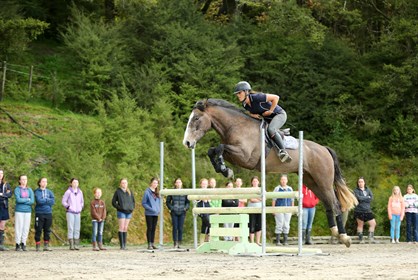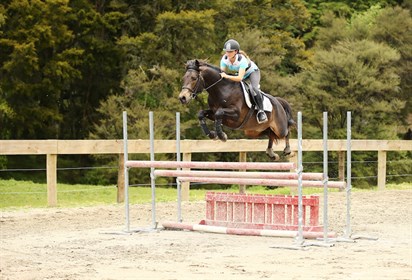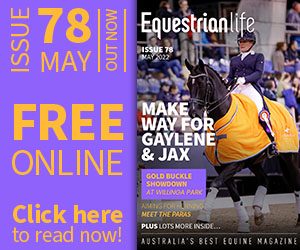|

|
This article has appeared previously with Equestrian Life. To see what's in our latest digital issue, click here.

Argo was mustered as a wild Kaimanawa stallion 15 months ago and is now preparing for his first jumping season.
You would expect a showjumping lesson with the Wilson sisters, to be different. For starters, their students are riding Vicki’s top Grand Prix horses. Secondly, all the girls ride without spurs, there are no training aids, no martingales, no draw reins, just simple snaffle bits.
We take a look back at this fabulous clinic, where Vicki had some great advice for aspiring young shopwjumpers....
WORDS BY UTE RAABE // PHOTOS BY KELLY WILSON
SUCH SIMPLICITY HAS become a rare sight on many showjumping arenas, where often the wildest combinations of bits and training aids are on display, and Vicki’s sister Kelly catches my surprised look. “We try and keep it as simple and uncomplicated as possible. We generally ride in a snaffle or no bit at all, for example, in a soft hackamore. We like our horses on a soft, loose contact. For us it’s all about happy horses that enjoy the work. Our training regime at home is simple too. Our horses rarely jump at home; they are schooled only once or twice a week. On the other days they swim in the river, go to the beach or hack around the farm. When they come out on the arena it is almost a novelty.”
Vicki adds: “There is nothing here that we want to hide. We have never rapped a horse or used artificial gadgets to create an unnatural scope.”
Kelly confirms: “I think the way we produce our horses is different from other people. The more exposure we have had to other trainers, internationally and in New Zealand, it’s made us more aware of how different we are in our methods. We won’t force our horses to do something, we want them to enjoy the work. They are performance horses and get treated like athletes in terms of their fitness and feed programme, but they’re not machines. Our horses are almost equal to ourselves; if something is not fun for us, it can’t be fun for them.”

Natural ability! Six-year-old pony stallion Highlight is flying.
Riding Vicki’s elite jumpers looks like fun, but it is also very beneficial for her students. They experience how a well-educated showjumping horse should feel and move. Vicki’s horses are sensitive to a poor ride; if a distance is not quite right or a rail drops, it is usually the young rider who didn’t press the right button.
“Some people say I am ruining my horses this way, but it is the only way you learn how to avoid mistakes,’’ says Vicki. “If you don’t have a good horse to sit on it becomes very hard to feel what you need to do.”
Alexa is riding Cadet MVNZ. The athletic 11-year-old chestnut gelding by Orame was a problem child before bonding with Vicki and is now jumping at World Cup level. Vicki addresses the combination: “Fix your canter and look through the turn, plan where you are going. I want you to be straight when you land. Shoulders back, leg on and slightly more connection. He needs contact so he feels secure and safe, and he needs to know where he’s going. Who is in control of the canter? It is not you… Put your leg on, more energy. You are supporting him, you are making his job easy for him. Look early and ride to the distance you see. He can jump out of any distance, but I need you to see it.” The pair clear the next jump beautifully and the coach is happy.
Kirsty and Levado GNZ are next. When he is not jumping other horses, people or cars, the Holsteiner Warmblood by Littorio competes successfully at Grand Prix level. “Soften and bring your shoulders back. Focus on that position. Think trot, think lower leg, create the trot,” Vicki commands.

If you don’t have a good horse to sit on it becomes very hard to feel what you need to do.
Vicki likes to refer to a classroom analogy, and her classroom rules are simple: it is all about balance, straightness and rhythm. “We have to become the world’s best teachers so our horse wants to keep coming back to us. I had an amazing maths teacher at high school. His philosophy was, if you do really good quality work and get everything done to a super high standard in a short timeframe, then the entire class can go out and play basketball or rugby for the remainder of that class. It made everyone want to do their work well so we could go and have fun. We take a similar approach with the horses. It’s an intense body workout for 20 minutes and then we go for a hack. We want to give them the best of both worlds.”
Tracey is jumping Highlight, a young pony stallion that is still very green but already displaying great jumping potential. “Our pony has scope. When you have scope you don’t need to be fast. Come out of the corner and maintain the quality of canter. Speed flattens the horse. We can be strong but not fast. Use your corners to prepare. You are training him, it is your responsibility and you are in control. Now he is starting to understand what you are wanting. Good girl,” Vicki praises.
Highlight is one of many horses sent to the Wilsons by their owners for regular training. Vicki explains: “We love starting our own horses, and we get many horses that come here for breaking in. Within 2-6 weeks we teach them to walk, trot and canter on the bit, do flying changes and pop over jumps. Our approach is to expose our young horses as much as possible to whatever it is they are going to see for the rest of their life. My job as a trainer is to give it tools that it is able to use for the rest of its life. When he goes out to his first show six weeks or two years later, he should think, ‘Great, it’s an adventure’. But when a horse is stuck in his arena and leads a sheltered life, it becomes very hard for them to adapt and change.

Rules of the classroom: balance, straightness and rhythm. Kirsty and Levado GNZ show how it’s done.
“Now we get as many professional horses for rehabilitation or life training. People realise how important it is for a horse to be happy. Even a performance horse needs to do something fun at least three or four times a week, it lightens them up. Arenas shut a horse down, it’s like a prison cell. Carl Hester is a good role model, his horses go out. They have to stay mentally and physically sound. We don’t do much with ours until they are six years old, so they have time to develop mentally.”
Vicki takes care when assessing new or “problem” horses. Her mindset is about finding a solution, not punishing the symptoms. “We see a lot of girls coming for lessons and their horses are stiff to one side or bucking. When we check them more closely we can feel that they are in pain. If I adjust them, I can guarantee those horses will go straight and relax. Horses don’t want to be naughty, they don’t want to be told off, they want to do the right thing. They are telling us that something is wrong or they are misunderstanding us. I can get any sore horse to jump, that’s not a problem, but a lot of riders can’t ride a sore horse, and when the horse is going badly they need to be asking themselves why. Do I need to ring the physio or do I need to ring the farrier? A typical problem is a horse that stops at a double. Many riders will say, ‘Oh it’s scared of doubles because it crashed through one.’ It’s generally because there’s a splint or similar. They feel the pain on the landing impact, and the second jump comes up too quickly for them to recover. Front splints make a horse stop, back splints make them rush. It’s different things like that and being aware of it.

Alexa and Cadet MVNZ, “Shoulders back, leg on and slightly more connection.”
“The biggest question to ask is why is my horse doing something? Why does he only run out to the left? It didn’t wake up that day to behave really naughtily, but it might have rolled the wrong way around in the paddock or kicked through a fence, and it might be really sore. When we ride we don’t punish the horse, we don’t use gadgets to correct the problem, we know it is not behavioural, but structural - so we either rest them or fix them. You watch a showjumping class and you can see which horses are sore… Yesterday we had an awareness class with our riders. I adjusted three horses and showed them where they were sore.”
Vicki has a passion for teaching and loves to see others improve and excel. Her years of experience competing, riding and training different horses have made her a highly effective and respected clinician and coach in her home country.
Her advice for Equestrian Life readers? “Enjoy everything you do, it’s got to be fun. If you are not enjoying something, your horse is definitely not. If you find work boring or too hard, it’s worse for the horse. Have adventures and have fun, it’s so important.”
Argo steps up
To show her students how much control they can exert through the right balance and position, Vicki gives a demonstration on Argo - bridleless - proving that impulsion and collection can be achieved without a bit. Argo changes seamlessly between collected and medium trot, while his rider provides a running commentary:
“I can ride anywhere I like and my horse stays at the same speed until I ask him to change. If I go ‘whoa’ and slow the rising, he is allowed to slow down and stay at that slow speed until I request him to go forward again. He has to do it off my body language and how I change my energy, my leg and my seat. I can add my voice to this as well. If he is not responding, I repeat the question and get him to concentrate and listen again.”
Vicki proceeds to canter and changes reins without Argo starting to rush. “He has to be in tune to my body to stay in the same rhythm. Sometimes he forgets me, because he is still a baby, but he always comes back to me and he loves to try. If I ask something and he gives it to me, I will take the pressure off and reward him. I don’t keep the pressure on, I have to praise him for the tiniest of tries because I want him to continue wanting to work for me.”
READ THE LATEST NEWS ARTICLES HERE

|

|

